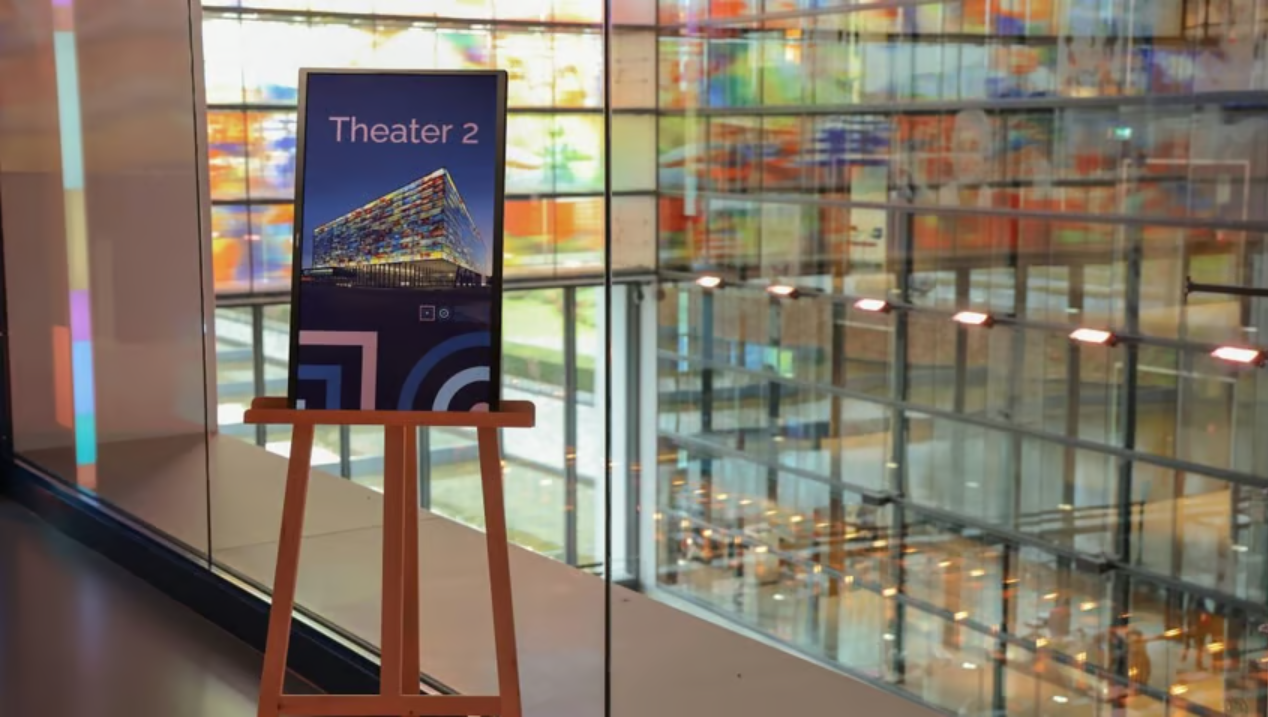The Beeld & Geluid museum, also known as the Netherlands Institute for Sound and Vision, has taken a bold step into the future of sustainable signage by installing Philips Tableaux zero-power e-Paper displays, marking a new chapter in green museum operations.
From Paper to e-Paper: The Shift
In its striking building of 2,244 rotatable glass panels, Beeld & Geluid curates an enormous archive of media. Those range from classic radio and television broadcasts to video games, podcasts, social media artifacts, and more. While the museum has long leveraged Philips AV displays as part of its visual identity, until now, staff still relied heavily on printed posters for welcome messages, exhibit labels, event notices, and wayfinding.
Concerned with paper waste, printing costs, and the logistical burden of managing physical signage, the museum sought a digital alternative that aligned with its sustainability and operational efficiency goals.
The Philips Tableaux Solution
In partnership with PPDS (the global provider of Philips professional displays), the museum deployed 25-inch Philips Tableaux ePaper displays across strategic spots within its galleries, lobbies, and event spaces. These displays boast a rare combination of zero-power operation and full-colour static imagery, meaning they require no electricity in steady state, consuming power only during content updates.
Each time content is changed, the system draws a minimal 0.0025 kWh. Otherwise, the displays sit in energy-free mode, acting much like digital posters with no ongoing electricity consumption.
The displays run on an Android SoC and offer multiple modes for content updates, which can be via USB, Wi-Fi, or LAN. Updates take around 36 seconds to apply. Because of their lightweight, cable-free design, the units can be placed (or repositioned) anywhere, even in areas without direct mains access.
For more flexible deployments, the displays can run on rechargeable 18650 batteries (not included) for months, depending on how often content changes. This enables usage in locations where wiring is impractical. This makes for a useful feature in delicate or historic museum interiors.
The museum also uses art-style easels and mounts to present the displays, visually bridging the transition from analog posters to sleek digital signage.
Benefits & Impact
The shift to Philips Tableaux brings several tangible benefits:
- Paper & ink waste elimination — The museum no longer needs to produce, distribute, and discard printed posters.
- Cost reduction — Reduced spending on printing, ink, materials, and logistics.
- Staff time savings — Centralized content management and schedule-based updates free up staff from manual poster replacements.
- Flexibility — Displays can adapt messaging dynamically (e.g. tailored greetings, exhibit updates) and be moved as needed.
- Energy efficiency — Because the displays draw zero power in idle mode, the energy cost over time is negligible.
Hylke Thiry, the museum’s team manager for sales and business development, commented on the alignment with the museum’s sustainability goals and its historic ties to Philips. The collaboration underscores a shared heritage in audiovisual innovation. Likewise, PPDS highlights this project as a showcase of sustainable display technology in a high-visibility public venue.
Looking Ahead: Scalability & Broader Trends
While Beeld & Geluid opted for the 25-inch model, Philips offers larger versions such as the 32BDL5150I/00, a 32-inch full-colour ePaper display with support for the PPDS Wave remote management ecosystem. The Wave integration allows users to remotely control firmware, scheduling, content playlists, and diagnostics across multiple displays.
The Beeld & Geluid implementation points to growing interest in sustainable digital signage, combining the permanence and low-maintenance appeal of static signage with the flexibility of modern digital displays. As museums, corporate buildings, airports, retail outlets, and public spaces aim to reduce their carbon footprints, zero-power or low-power ePaper signage may become a standard.
Challenges & Considerations
No technology is without trade-offs. Some considerations for institutions weighing this route include:
- Update latency — The time (≈ 36 seconds) to upload new content may limit ultra-dynamic signage use.
- Color refresh limits — Because the displays are optimized for static imagery, frequent full-screen updates might strain durability or battery life (if battery-backed).
- Initial cost — Higher upfront cost relative to conventional posters or even standard digital signage might be a barrier for smaller institutions.
- Content strategy — To maximize efficiency, institutions must plan what messaging truly needs the flexibility of digital vs. what can remain static for longer durations.
Conclusion
By adopting Philips Tableaux zero-power ePaper displays, Beeld & Geluid demonstrates how heritage institutions can evolve sustainably, marrying digital flexibility with environmental responsibility. The installation not only reduces waste and operational load but also becomes a symbolic bridge between the museum’s AV roots and its digital future.
As more venues look to diminish resource consumption without sacrificing display quality, Beeld & Geluid’s case may well inspire broader adoption of zero-energy e-paper signage technology.


